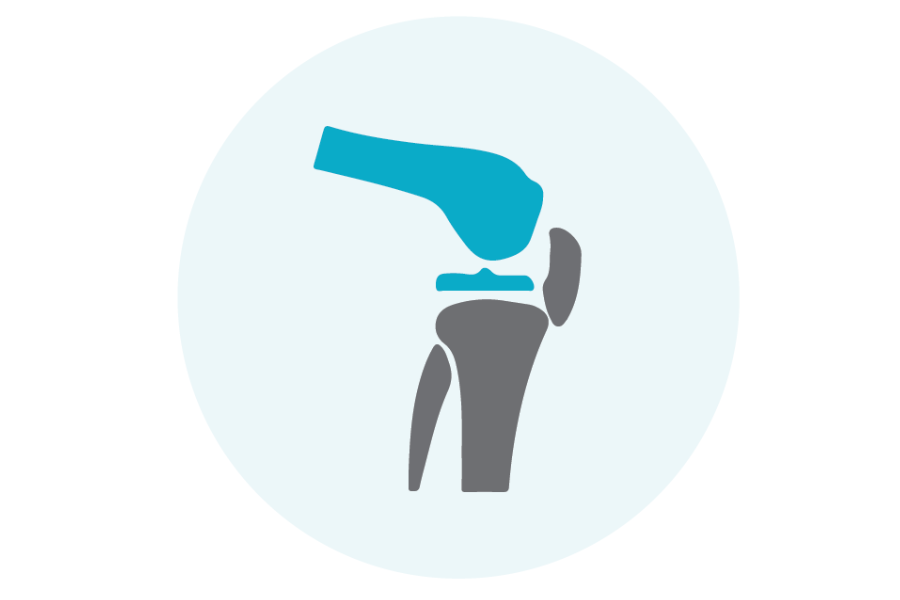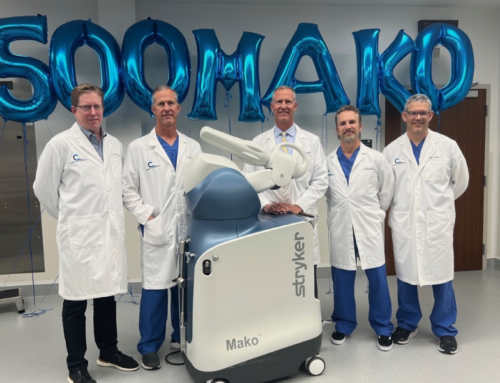
You may have experienced uncomfortable pain in your joints, knees, elbows, hips or shoulders during your daily activities. Maybe you know someone who has experienced something similar. When the pain from rubbing joints becomes too great and all other treatments have failed, our experienced orthopedic surgeons can explain and provide the benefits of joint replacement surgery to alleviate pain. This surgery removes the damaged or arthritic joint and replaces it with an artificial joint called a prosthesis.
What if I Need Joint Replacement Surgery?
Although each surgery is different, experienced doctors will know how to relieve the pain, so you can continue with your everyday activities. The duration of the surgery is correlated to the severity of the damage, and the method by which the surgery is performed.
During surgery, doctors replace the damaged joint with the prosthesis. The prosthesis is made of plastic, metal or a combination of both. Sometimes, doctors cement the joint into place; they won’t in some cases, so it allows the natural bone to grow into it. Cemented joints tend to be used for senior patients. Joints which aren’t cemented are used more for active patients with stronger bones. These may take a bit longer to heal since the patient needs to allow time for their natural bone to grow into it.
Your doctor may suggest you start physical therapy the day after your surgery. Strengthening the muscles will help you regain motion in the joint.
Who Needs Total Joint Replacement?
Anyone with arthritis or other joint complications is a candidate for joint replacement surgery. After the age of forty, men and women tend to be more at risk for these complications.
Every year, more than one million Americans have a hip or knee replaced. The people who suffer most from joint problems tend to be those who make daily repetitive motions, such as those who work in construction. For others, joint pain comes from diseases, injuries, arthritis or simply wear-and-tear of the joint over time. Replacing the joint alleviates pain, stiffness and swelling.
Only your doctor can tell you whether or not you need joint replacement. He or she may put an arthroscope, a small, lighted tube into your joint, to look for damage. Obtaining a small sample of the damaged tissue is also a testing possibility.
What is Outpatient Total Joint Replacement?
Today, more and more surgical procedures are done on an outpatient basis, i.e., requiring less than 24 hours of hospital recovery. This is slowly becoming more common with total joint replacement surgeries, such as knee and hip replacements. Once a major procedure requiring a lengthy hospital stay and an inability to work or drive for months after the surgery, it has now become significantly more manageable and thus more favored by orthopedic patients everywhere.
Total joint replacement is the solution of choice for those suffering from severe arthritis or other certain serious musculoskeletal injuries. The procedure involves a removal of the unhealthy joint cartilage, replacing it with an artificial joint structure designed to look and function as your natural joint once did.
To take this highly effective procedure one step further, orthopedic surgeons have improved their knowledge, equipment, and surgical techniques to offer total joint replacement on an outpatient basis. The benefits are as follows:
Minimally invasive surgery
- Shorter hospital stays – a few hours vs. 4-5 days
- Shorter recovery time – one week vs. 2 months
- Less pain after surgery
- The comfort of your own home during recovery
- Reduced risk of complications or infection
Although outpatient total joint replacement has been gaining prominence in recent years, it is currently not offered to everyone. The ideal candidate for this procedure does not suffer from any major ailments, is self-motivated towards a quick recovery, and has a reliable caregiver at home.
What is Arthroplasty?
Arthroplasty is a surgical procedure to restore the movement and function of a joint such as your hip or knee. These surgical procedures could be a partial or full replacement of the joint. During these procedures an artificial joint is placed in the joint’s position to improve movement and function. This artificial joint can also be called a prosthesis.
There are various diseases that can cause damage that requires a partial or full joint replacement. Some of these conditions include Osteoarthritis, degenerative joint disease, arthritis, and the loss of cartilage in a joint.
When medical treatments are no longer providing relief for your condition, surgery may be considered.
What is Arthroscopy?
Arthroscopy is a minimally invasive surgery to treat joint problems. This process allows the surgeon to make small cuts and perform the surgery using a modern video technique. This technique causes minimal pain, reduces complications and speeds up recovery.
An Arthroscopy allows the surgeon to perform delicate procedures to repair cruciate ligaments of the knee, remodel the meniscus, repair the rotator cuff, remove irregular cartilage and many more procedures without causing issues for future or more extensive surgeries.
When a Joint Replacement Surgery is Needed
There are many reasons why someone would need joint replacement surgery, whether full or partial. Some of the reasons include:
- Osteoarthritis: This wear-and-tear type of arthritis comes with age. In this condition, the cartilage cushioning the bones of the joint wears away, causing bone to rub on bone, resulting in hip pain and stiffness.
- Rheumatoid Arthritis: This is an autoimmune disease where the synovial membrane becomes inflamed and thickened. This is a chronic condition in which the inflammation can end up damaging the cartilage, which will lead to pain and stiffness.
- Post-Traumatic Arthritis: This type of arthritis can be caused by a serious injury or fracture. During the injury, the cartilage may have been damaged as well causing pain and stiffness later.
- Avascular Necrosis: This could have been an injury to the area that caused a dislocation or fracture and may have limited the blood supply. This condition is also known as osteonecrosis. The lack of blood flow could have caused the surface of the bone to collapse, leading to arthritis. There are other diseases that could also cause Avascular Necrosis.
- Childhood Hip Disease: Even in infancy and childhood, some people experience problems. In most cases these problems are successfully treated in the beginning, but they can still lead to arthritis later in life. This can happen due to the hip not growing normally, affecting the joint surfaces.
Total Hip Replacement Surgery
 Before undergoing total hip replacement surgery, there are other treatment options to consider. However, hip surgery may be recommended due to extensive damage caused by arthritis, a fracture, or many other conditions.
Before undergoing total hip replacement surgery, there are other treatment options to consider. However, hip surgery may be recommended due to extensive damage caused by arthritis, a fracture, or many other conditions.
If medication doesn’t work and changes your day to day activities, you should consult your doctor about whether a hip replacement surgery is right for you. Hip replacement surgery is a successful and safe surgery that is performed routinely by experienced surgeons.
Total Knee Joint Replacement Surgery
A total knee replacement may be needed because of arthritis or injury. Patients typically consider knee replacement surgery when everyday activities, like taking the stairs or even sitting, become more difficult or painful.
If medications are no longer effectively managing your pain, speak to your doctor about alternatives like total knee replacement. Knees are the largest joints in the body. When deciding on surgery, consider that healthy knees are important to perform most daily activities.
The three main reasons patients undergo knee joint surgery are Osteoarthritis, Rheumatoid Arthritis and Post-Traumatic Arthritis. Knee surgery is also known as knee arthroplasty; however, the most proper and accurate term would be called “resurfacing”, because, only the surface of the bones is replaced. This surgery is a procedure to relieve pain, correct leg deformity, and help you resume normal activities.
Total Elbow Replacement Surgery
Elbow replacement surgery is just as successful as knee or hip surgery and helps with relieving joint pain. Most patients that have surgery on their elbow joints experience improved quality of life. They experience less pain, improved motor skills, and increased function and strength.
When your doctor performs a total elbow replacement surgery, the damaged portions of the humerus and ulna are replaced with an artificial hinge made of metal and plastic with two metal stems. The stems of the artificial “elbow” are made and formed to fit inside the hollow part of the bone, called the canal. Like all joint replacements, elbow replacements can be partial or full, which your physician will discuss with you so you can make the decision that’s best for you.
Shoulder Joint Replacement Surgery
Like all joint replacement surgeries, the damaged parts of your shoulder are removed and replaced with artificial parts that are called prostheses.
Talk to your doctor about whether shoulder joint replacement is right for you. Consider the following questions:
- Are you having severe shoulder pain?
- Does your pain interfere with your everyday activities?
- Do you have moderate or severe pain while you’re resting?
- Have you experienced any loss of motion?
- Have you felt weakness in your shoulder?
- Have anti-inflammatory medications, injections or physical therapy stopped working for you?
If you have answered “yes” to most of the above questions, talk to your doctor about proceeding with surgery to increase motion and reduce pain and inflammation of your shoulder.
Wrist Replacement Surgery (Wrist Arthroplasty)
Wrist replacement surgery isn’t very common. The most common cause for this type of surgery is arthritis. Arthritis causes worn cartilage that can cause pain, inflammation and loss of motion. Wrist replacement surgery can help improve wrist movement with less or no pain.
In some cases, the bones in your wrist are fused together to help with strength and to reduce or eliminate the pain you may be having. However, if this procedure is done there will be no movement in the wrist itself.
How can you help someone after joint surgery?
The thought of total joint surgery may seem overwhelming at first. Even though this process is becoming easier, it’s still helpful to have one or two people around to help the patient post operation. Here are a few tips on how you can better help a total joint patient after surgery:
Communication
There are always going to be tips, tricks, and suggestions from others, but the most important person to listen to is the patient and the instructions given by their physician. Ask them if they are comfortable, if they need anything, if they would like something before you give it to them – all of these things help the patient feel less overwhelmed and more in control of the situation.
If they tell you that they are experiencing any type of medical symptoms (such as severe nausea, active bleeding, fever higher than 101.5, or changes in circulation) contact their physician immediately.
Keep Track
The two most important things to log are the patient’s medication and any questions you may have for their care team. Medication must be administered on schedule. You can keep a medication log that notates when the last dosage was given and when the next dose must be administered.
Comfort
There are many parts to assisting with comfort after surgery:
- Set Up the Right Space: You want to make sure that the patient has a comfortable space to rest in. This space should be located on the ground floor if they have had a lower extremity joint replaced (hip or knee) as it might be difficult for them to go up and down stairs. Make sure the resting space is easily accessible to the patient, not too high or too low as this might cause difficulty when getting up or sitting down.
- Be Prepared– You might want to have extra pillows and blankets nearby in the case they need extra support when sitting up or need elevation for their arms or legs. You will also want to make sure they have a charged cell phone to ensure they are able to contact you if you step away and they need assistance.
- Help with Daily Activities – The patient will have limited mobility for a few weeks and will need assistance with laundry, bathing, and food preparation.
Motivation
Having limited mobility can be stressful and frustrating to anyone. This is a time when communication is key. Express feelings without blame and without getting defensive. Practice good listening skills and try not to take things said out of frustration and impatience personally.
- Physical Therapy – In the beginning, they might express that they do not want to do their recommended exercises, remind them that what they are feeling is common and that rehab will help speed up their recovery. Helping to chart efforts, results, and progress may be motivating. Doing the exercises with them could also help keep them on track.
- Power of Positivity – Lack of mobility can not only lead to frustration, it can also cause severe boredom. Try to keep them busy with positive things they enjoy such as films, music, games, or other activities that do not require much movement. Many encourage comedy after surgery as laughter (though not clinically proven) has been said to make people feel better.
How to Protect Your Joints While Running or During Other Physical Activities
Many people enjoy staying fit and active by including physical activity such as running or exercise in their daily lives. Running and exercise are great ways to keep your body healthy and to burn calories. However, if you are not careful, you can harm your joints.
The good news is that there’s no reason to retire your running shoes just yet! Following these easy tips can keep your joints healthy! Read about these simple ways to protect your joints:
- Warm Up and Cool Down: Before and after, it is vital you spend some time warming up and cooling down. Stretching ensures your body is ready and helps to prepare your joints. Cooling down properly is equally as important. Gradually decreasing your workout intensity will reduce pain and discomfort in your joints.
- Increase Muscle Strength and Flexibility: You want to increase the range of motion and strength of your joints to ensure they are ready. On days when you’re not working out or running, try some low impact training exercises.
- Keep a Healthy Weight: Carrying a few extra pounds will put added pressure on your joints. This extra weight may be responsible for the pain you feel. Losing weight will also take away this pressure and relieve some of your pain. In addition to exercise, maintain a healthy and balanced diet.
- Get Rid of the Old Shoes: Old worn out shoes don’t offer the support your joints need. If you run frequently, then you will want to change out your shoes at least once a year to protect your leg joints. While it may be pricey, it will save you pain and your health is priceless.
- Don’t Over Exert Yourself: The worst thing you can do for your joints is overworking them. Doing any high impact exercise every day will wear down on your joints and cause pain. Take at least a couple days off every week to give your joints a break and a chance to heal.
Can the Temperature Outside Affect My Joints?
After months of intense Florida heat, many of us are ready to welcome a little cold weather in the Sunshine State, but when the temperature drops, you may find yourself in a little pain with tender, swollen and achy joints. Although studies are mixed on whether or not the weather can actually affect your joints, there seems to be a definite correlation between cold temperatures and joint pain.
- Barometric Pressure + Your Joints: While scientists can never seem to agree on the topic, there are theories that the barometric pressure in the air can wreak havoc in your joints. Barometric pressure is the force that is exerted by the weight of the atmosphere. When the temperature drops, a drop in barometric pressure tends to occur too. Some researchers hypothesize that as the barometric pressure drops, the tissues in joints swell and signal the body to feel pain.
- How to Combat Joint Pain When It’s Cold: While the scientific evidence on whether or not the cold can trigger joint pain remains conflicted, there are certain things you can do to combat joint pain during the cold months.
What Home Remedies for Arthritis & Joint Pain?
- Maintain a healthy diet: Eating a healthy, balanced diet is important year-round, but it may be especially helpful in the winter months. Make sure to pack in foods that are rich in omega-3 fatty acids, vitamin K and vitamin C found in foods like salmon, nuts, leafy greens and fresh fruits. Try to avoid eating refined grains or corn oil as these can trigger inflammation.
- Supplement with vitamins: Supplements may help your body fill in the nutrient gaps in your diet. Consider taking glucosamine sulfate to help lubricate the joints and be sure to get lots of vitamin D.
- Herbal Remedies: Did you know that herbalists have described Wild Cucumber Bark as “the best plant for treating rheumatism and arthritis?”. You can create an herbal remedy right at home by mixing equal parts of herbs and boiling water and letting it steep. Herbalists say drinking half a cup at least three times a day, yields greater results. Another popular herb used for joint pain is the Angelica herb. This herb has been used in European fold medicine for centuries. The Western variety of Angelica has multiple anti-inflammatory, anti-spasmodic and pain-relieving constituents.
- Get moving! When the winter months beckon, many of us tend to hide inside under a mountain of blankets. However, when we stop moving, our bodies tend to be more prone to aches and pains. Luckily, there are many exercises you can do from the comfort of your home, so you can stay warm while also improving your health.





